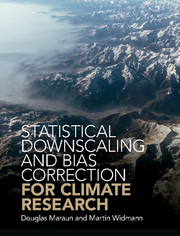Book contents
- Frontmatter
- Dedication
- Contents
- Preface
- Acknowledgements
- 1 Introduction
- Part I Background and Fundamentals
- 2 Regional Climate
- 3 History of Downscaling
- 4 Rationale of Downscaling
- 5 User Needs
- 6 Mathematical and Statistical Methods
- 7 Reference Observations
- 8 Climate Modelling
- 9 Uncertainties
- Part II Statistical Downscaling Concepts and Methods
- Part III Downscaling in Practice and Outlook
- Appendix A Methods Used in This Book
- Appendix B Useful Resources
- References
- Index
2 - Regional Climate
from Part I - Background and Fundamentals
Published online by Cambridge University Press: 27 December 2017
- Frontmatter
- Dedication
- Contents
- Preface
- Acknowledgements
- 1 Introduction
- Part I Background and Fundamentals
- 2 Regional Climate
- 3 History of Downscaling
- 4 Rationale of Downscaling
- 5 User Needs
- 6 Mathematical and Statistical Methods
- 7 Reference Observations
- 8 Climate Modelling
- 9 Uncertainties
- Part II Statistical Downscaling Concepts and Methods
- Part III Downscaling in Practice and Outlook
- Appendix A Methods Used in This Book
- Appendix B Useful Resources
- References
- Index
Summary
Before discussing regional climate modelling in more detail, it is sensible to briefly sketch regional climate itself, and the factors controlling regional climate and climate change.We use the term rather loosely, spanning a range of scales below the continental and synoptic scale. Some may prefer to distinguish between regional and local climate – we decided to use only one term – which scales we refer to should become clear from the context. In fact, we will discuss that it is essential to define the relevant scales for any user case individually. In some situations, a region might be a whole country, in other situations a district or even just a specific valley.
Regional climate is determined by a vast number of climatic processes spanning global to local scales. To successfully model regional climate change, it is essential to successfully model the processes relevant for the specific application. We will therefore sketch these processes in the following, considering the Alps as a showcase.
Large- and Planetary-Scale Processes
The global temperature field is to a first order determined by the influence of latitude and land–sea distribution on the radiative balance, and the different thermal capacity of land and ocean. The Alps are located in the mid-latitudes, in a temperate climate (Figure 2.1, left). The mid-latitudes are a region with a strong meridional temperature gradient and high baroclinic instability, which controls the position of the jet stream and fuels the North Atlantic storm track (Hoskins and Valdes 1990, Lynch and Cassado 2006). Jet streaks, regions of acceleration and divergence in the jet stream, control the genesis of cyclones. The upper-level winds also steer the path of cyclones. Conversely, the passage of cyclones along the storm track drives the jet stream, intricately linking the two phenomena (Woollings 2010). The Alps are located just south of the climatological mean position of the polar front and polar jet in both summer and winter. Cyclones and anticyclones advect different air masses to central Europe. For instance, arctic continental air brings cold and dry air, tropical maritime air is warm and moist, tropical continental air is hot and dry. The jet stream itself follows planetary-scale Rossby waves meandering around the globe.
Information
- Type
- Chapter
- Information
- Publisher: Cambridge University PressPrint publication year: 2018
